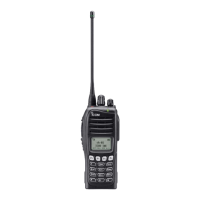■ Call procedure
When your system employs tone signalling (excluding
CTCSS and DTCS), this call procedure may be necessary
prior to voice transmission. The tone signalling employed may
be a selective calling system which allows you to call specific
station(s) only and prevent unwanted stations from contacting
you.
q Select the desired TX code channel or 2/5-tone code
according to your System Operator’s instructions.
• This may not be necessary depending on programming.
• Refer to pages 14 or 15 for selection.
w Push [Call] (assigned to one of the dealer programmable
keys)
e After transmitting, the remainder of your communication
can be carried out in the normal fashion.
Selective calling
Non-selective calling
■ Receiving and transmitting
CAUTION: Transmitting without an antenna may damage
the transceiver. See page 1 for accessory attachments.
Receiving:
q Rotate [VOL] to turn the power ON.
w Push [CH Up] or [CH Down], or rotate [ROTARY SELEC-
TOR]* to select the conventional system channel, in se-
quence.
*Depending on the pre-setting.
e When receiving a call, adjust the audio output level to a
comfortable listening level.
NOTE: When a matched RX code signal is received, audio
from the microphone is automatically transmitted for a
specified time period.*
* Depending on the presetting. Ask your dealer for details.
Transmitting:
Wait for the channel to become clear to avoid interference.
q While pushing and holding [PTT], speak into the micro-
phone at a normal voice level.
• When a tone signalling system is used, the call procedure de-
scribed at the previous page may be necessary.
w Release [PTT] to return to receive.
IMPORTANT: To maximize the audio quality of your signal;
1. Pause briefly after pushing [PTT].
2. Hold the microphone 5 to 10 cm (2 to 4 inches) from
your mouth, then speak into the microphone at a normal
voice level.
3
BASIC OPERATION
13

